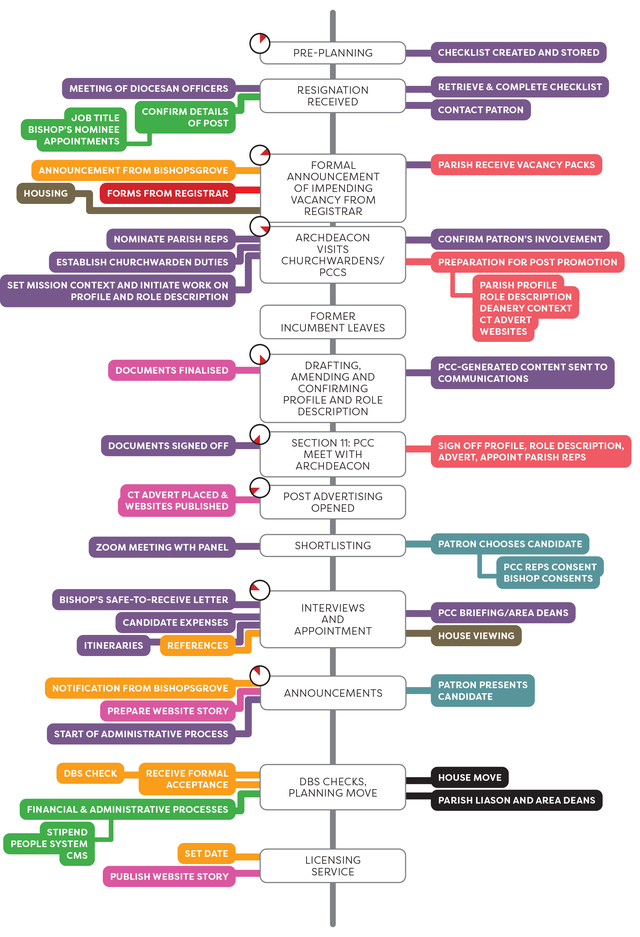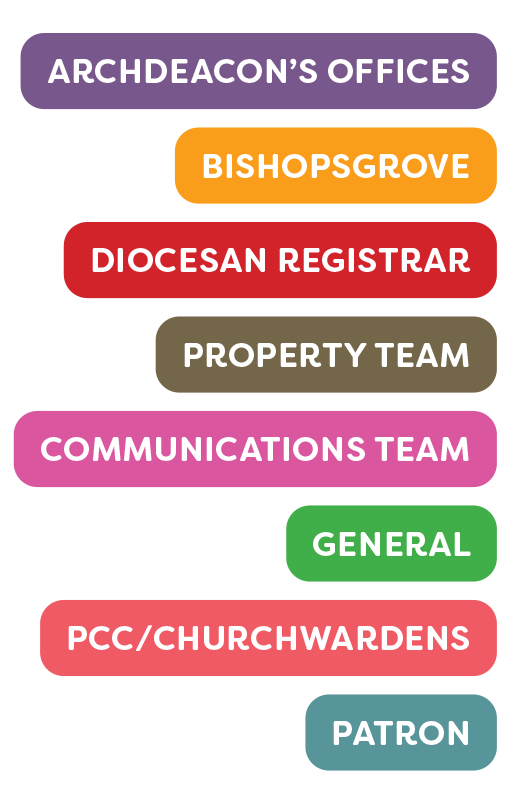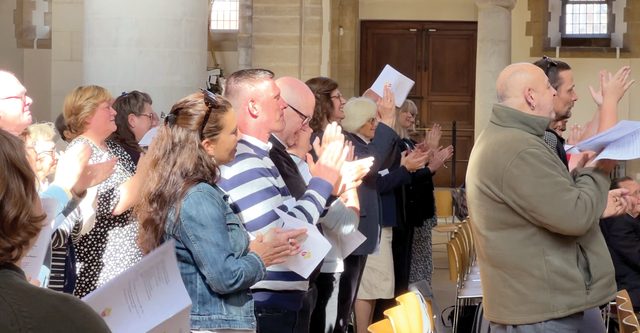
Parish Vacancy Timeline
Vacancy can be an exciting point in the life of a benefice. Decisions taken now are a seedbed for developing your mission in the years ahead. It is a time for the PCC to pray and ponder together, seeking God’s direction for mission, and working with others to find the Vicar, Rector or Priest-in-Charge (hereafter called Minister) God is sending to serve with you.
The aim of the Parish Vacancy Timeline is to de-mystify the process; to give you an understanding of its shape, and take you through it step by step. Your Archdeacon and their PA will be your point of contact throughout the process.
This timeline below gives a simplified model of the different steps of the Vacancy process as the months pass and guides you in what needs to be achieved at each stage:

 Here’s a useful key to know which department or agency is responsible for which item on the timeline.
Here’s a useful key to know which department or agency is responsible for which item on the timeline.
From the announcement to the departure of the former minister
 Once your previous minister announces their departure, the Archdeacon meets your churchwardens to plan for the vacancy. In the vacancy period your churchwardens, together with the Area Dean, are responsible to the Bishop. This is a period where teamwork is essential, when you, as members of the PCC, together with the wider congregation pull together as a team so that things can run as smoothly as possible.
Once your previous minister announces their departure, the Archdeacon meets your churchwardens to plan for the vacancy. In the vacancy period your churchwardens, together with the Area Dean, are responsible to the Bishop. This is a period where teamwork is essential, when you, as members of the PCC, together with the wider congregation pull together as a team so that things can run as smoothly as possible.
Although in these first few months the churchwardens are busy organising for the vacancy, this is still a period in which the PCC can be getting ready for what will follow. In particular the PCC can:
- Pray and think about future directions in mission and life – looking again at previously set priorities and assessing how far these have progressed;
- Collect statistics from census – Mosaic data, which includes good visual representations of the census data, is available from from Canon Nick Ralph, and the parish finance information via parishreturns.churchofengland.org;
- Prepare survey questionnaires (if desired) for use with the wider congregation;
- Collect a small library of photographs for the recruitment documents and ensure that permissions are in place should the PCC decide to use them;
- List key contacts in the local community whose views might be helpful to you in developing the recruitment documentation.
Visits from the Archdeacon
 The Archdeacon exercises leadership in strategy and mission within the Archdeaconry. He/She is coming as your pastor, with instruction from the Bishop. The aim is to help the congregation think and pray creatively about the mission of your benefice so that the rest of the recruitment process can focus on finding a minister who can lead you forward in your mission.
The Archdeacon exercises leadership in strategy and mission within the Archdeaconry. He/She is coming as your pastor, with instruction from the Bishop. The aim is to help the congregation think and pray creatively about the mission of your benefice so that the rest of the recruitment process can focus on finding a minister who can lead you forward in your mission.
The Archdeacon is responsible for the first few stages of the vacancy process. The visit to the PCC will take place early in the vacancy and will:
- Give the PCC a good understanding of the vacancy and recruitment process;
- Explain the next steps – drafting a Benefice Profile and a Role Description for your new minister;
- Create a small drafting group to begin work on a Benefice Profile and a Role Description.
The Archdeacon will continue to be a source of help and advice as the PCC works together on the Benefice Profile and a Role Description.
Benefice Profiles and Role Descriptions
 The Profile and Role Description are hugely important. There are more clergy roles than clergy to fill them, and you want someone who can take the life of your benefice forwards. Clergy are not usually appointed on fixed terms. The person recruited now may be with you for a long time, so it’s important to get it right. It is on the basis of what you now write that clergy will decide whether or not to apply.
The Profile and Role Description are hugely important. There are more clergy roles than clergy to fill them, and you want someone who can take the life of your benefice forwards. Clergy are not usually appointed on fixed terms. The person recruited now may be with you for a long time, so it’s important to get it right. It is on the basis of what you now write that clergy will decide whether or not to apply.
Benefice/Parish profiles
After reading your Profile you want potential candidates to:
- have a sense of the directions in which you believe God is calling you;
- “feel” your benefice and community as a living, breathing organism;
- appreciate the team of people with whom they will be working, and the role they might play in that team.
Each profile must honestly reflect the life of the benefice, but remember that it must also be attractive to potential candidates. Nevertheless, it makes sense to benefit from the wisdom of experience. The Archdeacon will help you by offering some good examples.
All diocesan profiles now carry the same branding and design, created by our communications department in conjunction with the Archdeacon’s office and the parish.
Role descriptions
Since 31st January 2011 everyone appointed to a parochial office receives a Statement of Particulars setting out the terms of their office, including remuneration, housing, time off and annual leave. The Statement of Particulars for each post is produced by the Archdeacon’s office and none of these standard terms is included in the Role Description.
A Role Description:
- Highlights the key gifts and experience necessary for a post, both for prospective applicants and for those who shortlist and interview.
- Provides a framework of expectations for the office holder as they determine their day to day priorities and as they engage in their Pastoral Consultation with the Bishop.
- Provides a focus for further development of skills and abilities to support the office holder’s ministry.
Role Descriptions need to be realistic, relevant to their particular context, and generally agreed by those concerned. Involving colleagues and PCCs in their production minimises the potential for future misunderstanding and conflict. A generic job description would not help in differentiating between posts for any of these purposes. The Role Description is not a list of jobs or tasks to undertake. These will vary over time. Rather, it identifies the particular gifts and skills which the benefice needs in its minister for the next phase of its mission.

The Section 11 meeting
 Section 11 is a full PCC meeting. The Archdeacon must attend the start to make sure that the PCC clearly understands the decisions being taken but may leave after that. There should be no surprises at this point. The Section 11 Meeting is a bit like a starting gun. Hereafter, events unfold fairly swiftly.
Section 11 is a full PCC meeting. The Archdeacon must attend the start to make sure that the PCC clearly understands the decisions being taken but may leave after that. There should be no surprises at this point. The Section 11 Meeting is a bit like a starting gun. Hereafter, events unfold fairly swiftly.
Choosing PCC representatives
Each PCC appoints two elected lay members of the PCC to be the PCC’s representatives in the interview process. National Church of England guidelines recommend that the composition of the panel is balanced so far as possible in terms of age, gender and race, while recognising that this cannot always be achieved.
Nomination or advertising?
At the Section 11 meeting the PCC will discuss whether they will advertise the vacant post or will accept a Bishop’s nomination.
Advertising process
- the post is advertised,
- applications invited,
- a shortlist constructed, and
- interviews held.
Bishop’s nomination
It is also possible to ask the Patron and Bishop to consider the Profile and Role Description, and introduce candidates whom they consider to be well suited. Your Bishop and Archdeacon will have been praying for you throughout your vacancy and may have a sense of one or more possible candidates. Your Archdeacon is likely to be able to advise you whether, should the PCC ask them to do so, the Bishop and Patron would introduce such candidates to you.
Advertising & Shortlisting
 If you are advertising in print media such as Church Times, the communications team will design an advert based on your profile and role description.
If you are advertising in print media such as Church Times, the communications team will design an advert based on your profile and role description.
If we invite a maximum of four, or very occasionally five, candidates to interview then shortlisting is necessary. Shortlisting usually involves the Chair (Bishop or Archdeacon), the PCC representatives, the Area Dean, and the Patron.
At the shortlisting meeting the questions to be asked to the candidates (and presentation subject if one is being requested) are discussed. The same questions must be posed to all candidates at interview.

The Interview & Appointment
 Interview
Interview
This is where your newly elected PCC Representatives pick up the running, with the support of the Area Dean. There are four steps to running a good interview process:
- Plan
- Prepare
- Interview
- Decide
Early in the programme the candidates explore the benefice with you, visiting important locations and meeting key people. Churches of the benefice are obvious locations, but don’t forget local institutions and significant players and partners in the community with whom your new minister might be expected to work. Please don’t forget to organise a visit to the local schools (church schools or otherwise) and ideally, ask the schools to plan in an interview for each of the candidates, with members of the School Council.
Decide
The decision is shared between PCC Representatives, Bishop/Archdeacon, Area Dean and Patron (if attending). Whenever possible they should try to reach a unanimous decision. Remember that you are recommending the appointment of the candidate, not their spouse and family.
Following a decision, the Archdeacon’s office will contact all candidates to let them know the outcome and offer feedback. When a suitable candidate accepts the post, the Bishop’s office is responsible for all subsequent processes.
Pitfalls
Clergy occupy their offices not as employees but under a legal framework called Common Tenure. Presumptions and practices common in employment legislation are however increasingly pressing upon clergy terms of service.
Grievance procedures and employment tribunals do arise and have occurred in the Diocese. If a recruitment procedure is not properly run individuals, including Patrons and PCC representatives, might find themselves sitting in a witness box to justify their behaviour, with the risk of consequences if the complaint is upheld.
Interviews should be conducted to the highest standards. Questions which indicate prejudice against a person on the grounds of marital state, age, race, disability, background or education are not permitted under Equal Opportunities legislation.
From interview to licensing – bringing it in to land!
 Communicating the Decision
Communicating the Decision
The person who has accepted the appointment is coming from somewhere and their current parish needs to hear of the appointment in an orderly way. The Bishop of the Diocese from which they are coming also needs to give their consent to the change. Background checks such as Safeguarding clearance from DBS (the disclosure and barring service) also need to be obtained.
The Bishop’s office will co-ordinate the interested parties and make a formal announcement. There will also be a verbal announcement simultaneously at the incoming and outgoing parishes usually on a Sunday morning. An announcement will also be made on our diocesan website and digital channels.
The formal announcement by the Bishop’s office will give the name of the person appointed and the parish from which they will be coming, together with the proviso that the appointment is subject to satisfactory Safeguarding checks.
After the announcement has been made
Over the next few weeks there will be several opportunities to speak with and meet your new minister and to talk further about their role and the benefice.
The Property Team leads on housing and will meet your new minister at the benefice house to decide on preparations for the house.
Service
The service is a “Collation” when the Bishop is the patron, an “Institution” when there is a private patron, and “Licensing” when the patronage has been suspended.
The date of the service is decided by the Bishop in consultation with the Bishop’s Chaplain, Area Dean, Archdeacon, Patron and Churchwardens.
Reception/Party
Refreshments in a suitable place after the service is a great way for the new minister to meet parishioners, visiting clergy and guests.
Finally, a pleasant welcome to the benefice house for the Minister and their family is a kitchen stocked with a few essentials.
